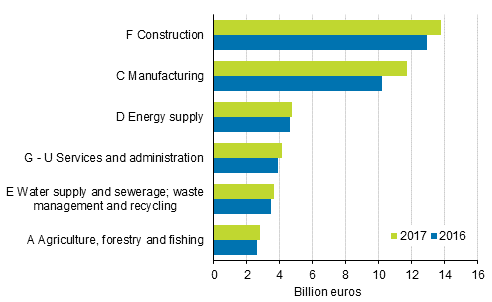Published: 13 December 2018
Weight of the environmental goods and services sector has grown
The value of Finland's environmental goods and services sector was nearly EUR 41 billion in 2017. Good 136,000 staff-years were made in the environmental goods and services sector and its exports amounted to around EUR nine billion. The value added of the environmental goods and services sector was over EUR 13 billion, which was around seven per cent of the value added of the entire national economy. The share of the value added of the environmental goods and services sector in the entire national economy has grown by around one percentage point from 2012 to 2017. These data derive from Statistics Finland’s statistics on the environmental goods and services sector.
Turnover of the environmental goods and services sector by industry in 2016 and 2017, EUR billion

The turnover of the biggest industry of the environmental goods and services sector, construction, was in 2017 almost EUR 14 billion, that is, one-third of the whole environmental goods and services sector. Good 34,000 staff-years were worked in construction and its value added was good EUR two billion.
In 2017, the majority of the turnover from the environmental goods and services sector, 85 per cent, was connected to resource management and the remaining 15 per cent to environmental protection. The biggest product categories of resource management were heat and energy saving and management, with a turnover of over EUR 13 billion, production of energy from renewable resources, around EUR eight billion, and management of minerals, with a turnover of good EUR five billion. The biggest product categories of environmental protection were waste water management with a turnover of over EUR three billion and waste management with a turnover of EUR two billion.
The value of the turnover from the environmental goods and services sector increased by almost eight per cent from 2016 to 2017. The value of the value added grew by over nine per cent and that of exports by nearly 17 per cent. The number of staff-years increased by close on two per cent. The majority of the growth in the environmental goods and services sector is explained by increases in low energy construction, the use of recycled metals in the metal industry and the production of bio-based chemicals.
The concepts and definitions of the statistics are based on EU Regulation (No 691/2011 and 538/2014) on European environmental economic accounts and on Eurostat's manuals. Starting from the environmental goods and services sector 2015 release, the statistics are not comparable with the old statistics based on a sample inquiry.
Source: Environmental goods and services sector 2017, Statistics Finland
Inquiries: Sami Hautakangas 029 551 3791, ymparistotilinpito@tilastokeskus.fi
Director in charge: Ville Vertanen
Publication in pdf-format (241.4 kB)
- Tables
-
Tables in databases
Pick the data you need into tables, view the data as graphs, or download the data for your use.
Appendix tables
- Appendix table 1. Turnover of the environmental goods and services sector by industry 2012-2017, million euros (13.12.2018)
- Appendix table 2. Value added of environmental goods and services sector by industry 2012-2017, million euros (13.12.2018)
- Appendix table 3. Exports of environmental goods and services sector by industry 2012-2017, million euros (13.12.2018)
- Appendix table 4. Employment of environmental goods and services sector by industry 2012-2017, full time equivalent (13.12.2018)
- Appendix table 5. Turnover of the environmental goods and services sector by product classes 2012-2017, million euros (13.12.2018)
- Figures
Updated 13.12.2018
Official Statistics of Finland (OSF):
Environmental goods and services sector [e-publication].
ISSN=1799-5108. 2017. Helsinki: Statistics Finland [referred: 19.4.2025].
Access method: http://stat.fi/til/ylt/2017/ylt_2017_2018-12-13_tie_001_en.html

